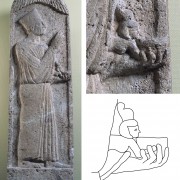Umm el-ʿAmed: Research on the Hellenistic Commemoration Stelae
Funding of Research in Archives and Museums
Henrike Michelau (Tübingen)
In total 23 stelae dating between the 4th and 2nd cent. BCE are known from Umm el- ʿAmed depicting upright men and women in an adoration gesture. The figures can be subdivided into three groups: (1) females; (2) males wearing a short robe, and (3) males wearing a long robe, a headdress and holding a cult-object. Furthermore, the inscriptions mention certain titles (priest, chief, chief of gates) for those male persons who wear a long robe and hold a cult object in their hands. The majority of the male persons in a long robe hold a specific cult object in their hands. It consists of a hand-seized bowl with an elongated handle in the shape of a nude girl. This type of object is known as the “swimming girl” from ancient Egypt, where it originally was used as a cosmetic spoon.
Thanks to financial support by the Deutscher Palästina-Verein it was possible to visit different museums and archives for research purposes. The result was that besides the stelae from Umm el-ʿAmed the man in the long robe with headress holding the swimming girl is also present on an altar block from Umm el-ʿAmed, found in the Milkaštart-temple and on a group of terracottas from el- Ḫarāʿib and Gaza.
Further Information
Further projects funded by the Society
Dieser Beitrag ist auch verfügbar in: German







